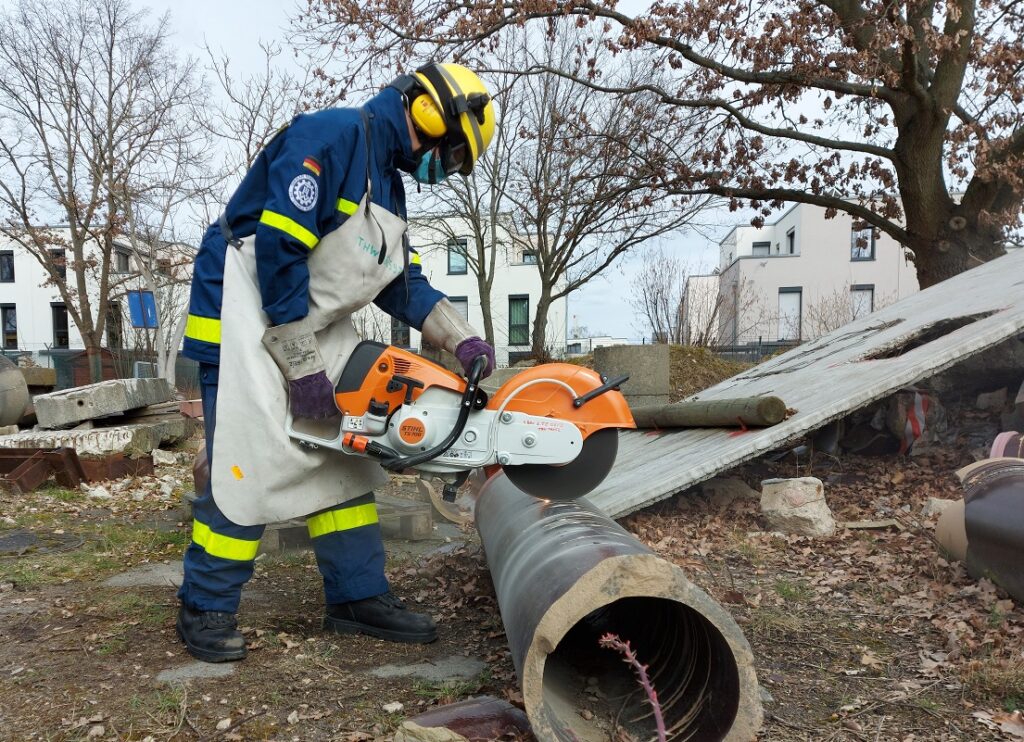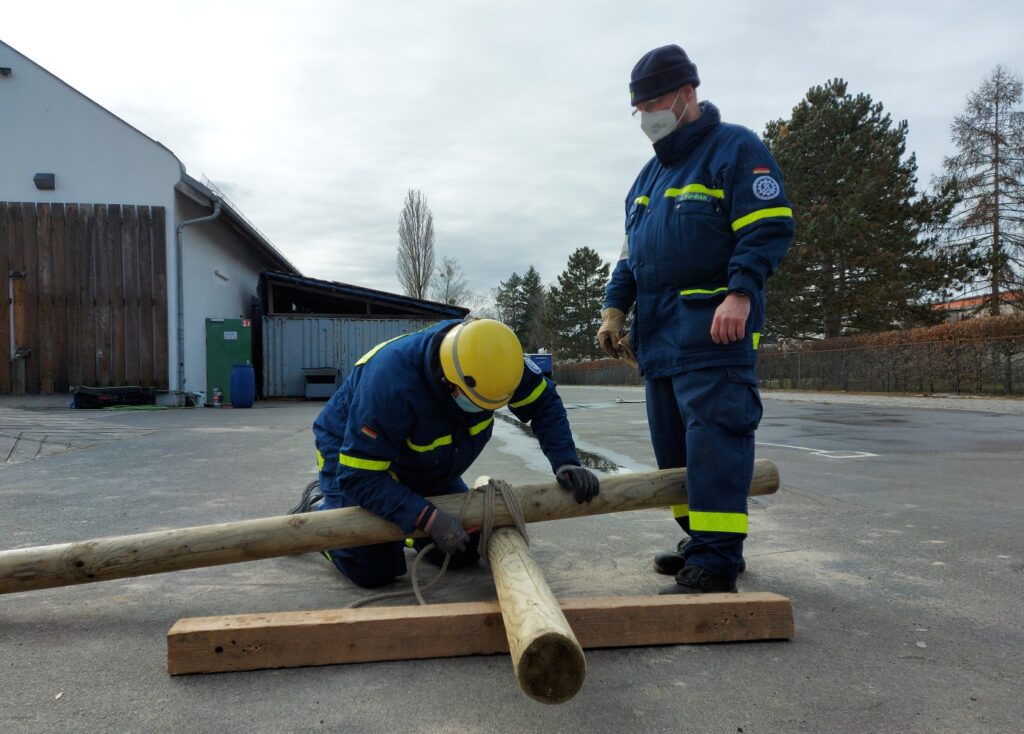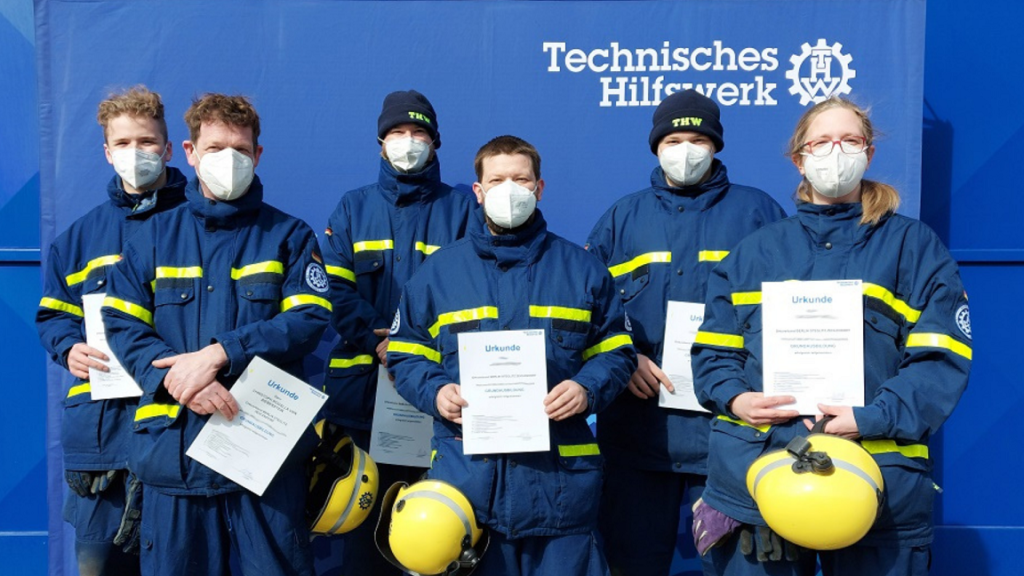The German Federal Agency for Technical Relief (THW) is an important partner in the development of KulturGutRetter and thus also in efforts to protect endangered cultural heritage. The coordinator of the project KulturGutRetter (KGR) – An Emergency Mechanism for Cultural Heritage in Crisis Situations at the German Archaeological Institute (DAI), Christoph Rogalla von Bieberstein, recently completed basic technical training with the THW alongside his work at the DAI.
In the event of a natural disaster, action must be taken rapidly – but safeguarding, rescuing and salvaging need to be learned. At a THW training centre in Berlin, aspiring members of the relief agency show what they have learned over the past few months. A derailed train wagon is heaved clanking back onto the tracks, and the examinees have to prove they can handle an electric angle grinder safely. Christoph Rogalla von Bieberstein, coordinator of the KulturGutRetter project, is among those taking the test here at the Steglitz-Zehlendorf section in Berlin to obtain their THW basic training certificate and thus become full members of the THW. In the past few months the restorer of archaeological artefacts has learned among other things how to shift loads safely, how to tie knots and fasten objects with a cord, and how to use heavy hydraulic machinery. The basics of rescuing and salvaging, first aid, and civil protection and disaster assistance were also part of his training. For this specialist in protecting cultural property, the expertise imparted by the German Federal Agency for Technical Relief is a keystone in the development of a globally integrated mechanism for the protection and rescue of cultural assets at grave risk of destruction.

Expertise in the protection of cultural heritage at risk
A series of disasters in the past, like the explosion in the port of Beirut, the fire at the National Museum in Rio de Janeiro or the collapse of the Cologne municipal archives have shown that units specialized in the protection of cultural heritage are indispensable in emergencies and crisis situations.
The aim of KulturGutRetter is for the expertise in emergency and disaster relief that exists in Germany to be concentrated in a team of experts that can act quickly in the event of a crisis to provide assistance internationally in securing, preserving and if need be salvaging objects and buildings. A mechanism for this purpose is currently being developed at the German Archaeological Institute (DAI) in association with the German Federal Agency for Technical Relief and the Leibniz-Zentrum für Archäologie (LEIZA). The partners can exploit the combined expertise of the Archaeological Heritage Network (ArcHerNet) and build on the positive experiences from the collaborative project Zero Hour – A Future for the Time after the Crisis. The initiative is supported by the Federal Foreign Office and the German Federal Parliament.

Lashing poles together with a cord: the test at the end of the basic technical training course | Photo: Vanessa Krieger, THW
The THW’s wide array of skills in disaster response and preparedness, combined with the KGR specialists’ expertise in protecting, conserving and documenting cultural property, are the foundation stone for the development of a rapid and efficient mechanism for rescuing and recovering cultural assets at risk, in the view of Christoph Rogalla von Bieberstein. The coordinator of the KulturGutRetter project is therefore delighted to have acquired the THW as a strong partner in the collaborative project:
“With its technical and operational capabilities the THW has proved itself throughout seven decades. The wide-ranging specialist skills and the fantastic team spirit of the volunteers are unique in Germany and beyond. Who if not the THW could be the ideal partner for the KGR in the event of deployment?”

THW basic training
While taking the THW basic training course, Christoph Rogalla von Bieberstein had an opportunity to get to know the cooperation partner’s way of working. He was impressed by what he saw: “I find it remarkable how serious the training was and how unwaveringly high the commitment shown by the volunteer trainers was, who would work in all weathers and keep calm and act professionally in every situation. Through the THW basic training course I learned how to handle machinery safely, how to act competently in operational scenarios, and also the capabilities of action boost the self-confidence of the helpers on the basic training course.”
Das Technische Hilfswerk
For around 70 years now, the THW has been in action on a daily basis, providing technical relief. The THW’s responsibilities include salvaging and rescue, establishing and maintaining infrastructure as well as logistics at the deployment location, and command support. Since it was founded, the THW has delivered humanitarian aid on behalf of the German government in 144 countries in response to external appeals for help. About 80,000 people work for the THW on a voluntary basis at its 668 local sections across Germany (source: 2020 Annual Report). One of the members is Christoph Rogalla von Bieberstein, who recently completed a basic training course.
________________
Title image: The THW section Steglitz-Zehlendorf in Berlin already has gained some experience in the field of cultural heritage rescue through supporting the Staatliche Musseen zu Berlin in Dahlem. | Foto: Technisches Hilfswerk, THW.

